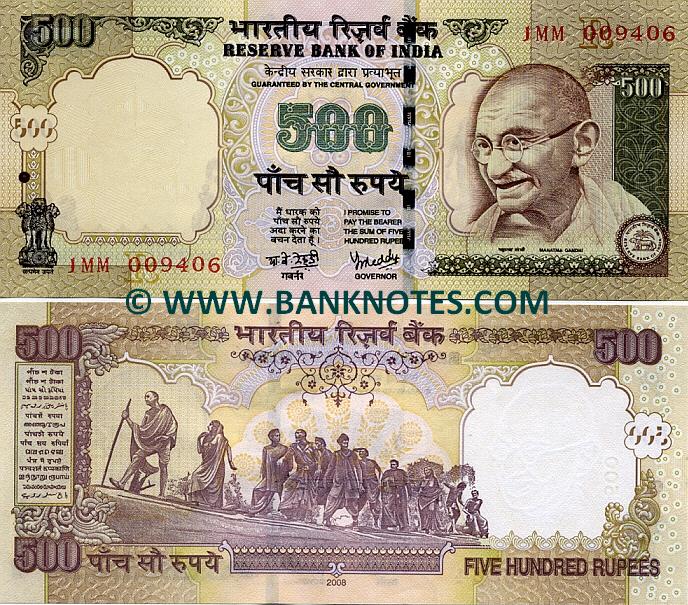500 Rupees 2005-2012 (Front: National Emblem of India - Lion Capital of Asoka (Ashoka column), sculpted from sandstone, preserved at Sarnath Museum which was originally erected around 250 BCE atop an Ashoka Pillar at Sarnath. The wheel "Ashoka Chakra" on it's base is a centerpiece of National Flag of India. "Satyameva Jayate" National Motto of India* is inscribed under it. Mohendas Karamchand "Mahatma" Gandhi (2 October 1869 – 30 January 1948). Seal of the Reserve Bank of India. Reverse: Mahatma Gandhi and his followers: "March to Dandi", sculpture in front of President's Palace in New Delhi. Watermark: Mahatma ("Great Soul") Gandhi; Electrotype 500. Security features: Consecutively running red horizontal serial numbers on the front of the banknote. Segmented (windowed) 2.5 mm wide security thread with inscriptions 'RBI' with colour shift from green to blue when viewed from different angles. Serial numbers and the security thread fluoresce under ultraviolet light. Omron-anti photocopying circles. Predominant colour: Yellowish brown. Design: Collective design by RBI Department of Currency Management, The Planning Division of RBI and the National Institute for Design. Signature: Dr. Duvvuri Subbarao (22nd Governor of RBI; served from 6th of September 2008 until 4 September 2013). Printing method: Intaglio printmaking. Issuer: Reserve Bank of India. First date of issue: 21 October 2005. Date of issue: 2010. Redeemable until: 30 June 2016. Date of withdrawal: 2014-2016. Demonetised: 8 November 2016. Material: Cotton paper. Printer: Security Printing and Minting Corporation of India Limited)
Plate letter "R"
Dimensions: 167 x 73 mm
Catalogue Number: P-99w (SCWPM: Albert Pick; Krause Publications)
Texts: Reserve Bank of India. Guaranteed by the Central Government. I promise to pay the bearer the sum of Five Hundred Rupees.
National Emblem of India
The National Emblem of India is derived from the time of the Emperor Ashoka. The emblem is a replica of the Lion of Sarnath, near Varanasi in Uttar Pradesh. The national emblem of India was adapted by the Government of India on 26th January 1950. The National emblem (out of the four lions only three lions are visible and the fourth one is hidden from the view) symbolises power, courage and confidence. It rests on a circular abacus. At the centre of the Abacus, there is a Chakra (wheel) which symbolises the Dharma Chakra (Eternal wheel of law). The abacus is girded by four smaller animals, guardians of the four directions: The Lion of the North, The Elephant of the East, The galloping Horse of the South and The Bull of the West, separated by intervening wheels over a bell shaped lotus. The word Satyameva Jayate (truth alone triumphs) have been inscribed in Devanagari script. The National emblem of India is the official seal of the President of India and Central and State Governments. The National emblem is used only for official purposes and commands highest respect and loyalty. It is also a symbol of independent India's identity and sovereignty.
Plate letter "R"
Dimensions: 167 x 73 mm
Catalogue Number: P-99w (SCWPM: Albert Pick; Krause Publications)
Texts: Reserve Bank of India. Guaranteed by the Central Government. I promise to pay the bearer the sum of Five Hundred Rupees.
National Emblem of India
The National Emblem of India is derived from the time of the Emperor Ashoka. The emblem is a replica of the Lion of Sarnath, near Varanasi in Uttar Pradesh. The national emblem of India was adapted by the Government of India on 26th January 1950. The National emblem (out of the four lions only three lions are visible and the fourth one is hidden from the view) symbolises power, courage and confidence. It rests on a circular abacus. At the centre of the Abacus, there is a Chakra (wheel) which symbolises the Dharma Chakra (Eternal wheel of law). The abacus is girded by four smaller animals, guardians of the four directions: The Lion of the North, The Elephant of the East, The galloping Horse of the South and The Bull of the West, separated by intervening wheels over a bell shaped lotus. The word Satyameva Jayate (truth alone triumphs) have been inscribed in Devanagari script. The National emblem of India is the official seal of the President of India and Central and State Governments. The National emblem is used only for official purposes and commands highest respect and loyalty. It is also a symbol of independent India's identity and sovereignty.





